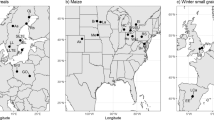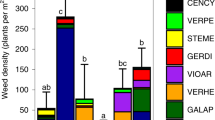Abstract
Understanding the role of diversity in the functioning of ecosystems has important implications for agriculture. Previous agricultural research has shown that crop rotation and the use of cover crops can lead to increases in yield relative to monoculture; however, few studies have been performed within the broader context of diversity–ecosystem function theory and in the absence of chemical inputs. We performed a field experiment in SW Michigan, USA, in which we manipulated the number of crop species grown in rotation and as winter cover crops over a 3-year period to test if varying the number of species in a rotation affected grain yield, a critical metric of ecosystem function in row-crops. The experimental design was unique in that no fertilizer or pesticides were used, and the only management variable manipulated was number of species in the rotation, thus providing a strong comparison to grassland diversity–ecosystem function experiments. Treatments included continuous monocultures of three row-crops, corn Zea mays L., soybean Glycine max (L.) Merr., and winter wheat Triticum aestivum L., and 2- and 3-year annual rotations with and without cover crops (zero, one, or two legume/small grain species), encompassing a range of crop diversity from one to six species. Crop yields and weed biomass were measured annually for 3 years and plant available soil nitrogen was measured over the course of the growing season in the final year of the study. In all 3 years, corn grain yield increased linearly in response to the number of crops in the rotation. Corn yields in the highest diversity treatment (three crops, plus three cover crops) were over 100% higher than in continuous monoculture and were not significantly different from the county average for each of the 3 years despite the absence of chemical inputs. Corn yields in the diversity treatments were strongly correlated with the availability of inorganic soil nitrogen, which was likely influenced by the number of different legume species (crops and cover crops) present in the rotation. In soybean and winter wheat, yield differences among crop diversity treatments were also significant, but of lower magnitude (32 and 53%, respectively), and showed little direct relationship to the number of crop species grown in a rotation. Results demonstrate that agricultural research motivated by ecological theory can provide important insights into the functioning of agroecosystems and enhance our understating of the linkages between diversity and ecosystem function. Importantly, these results suggest that reduced chemical inputs do not necessarily result in yield penalties and provide support for incorporation of crop or species diversity when determining how ecosystem services can be included in food, fiber, and biofuel production.




Similar content being viewed by others
References
Altieri MA, Letourneau DK, Davis JR. 1983. Developing sustainable agroecosystems. BioScience 33: 45–9.
Anderson RL. 2005. Improving sustainability of cropping systems in the Central Great Plains. J Sustain Agric 26: 97–114.
Andow DA. 1991. Vegetational diversity and arthropod population response. Annu Rev Entomol 36: 561–86.
Boman RK, Westerman RL, Raun WR, Jojola ME. 1995. Time of nitrogen application-effects on winter wheat and residual soil nitrate. Soil Sci Soc Am J 59: 1364–9.
Bullock DG. 1992. Crop-rotation. Crit Rev Plant Sci 11: 309–26.
Crookston RK, Kurle JE, Copeland PJ, Ford JH, Lueschen WE. 1991. Rotational cropping sequence affects yield of corn and soybean. Agron J 83: 108–13.
Crum JR, Collins HP. 1995. KBS soils. http://lter.kbs.msu.edu/Soil/Characterization
Delate K, Cambardella CA. 2004. Agroecosystem performance during transition to certified organic grain production. Agron J 96: 1288–98.
Diaz S, Cabido M. 2001. Vive la difference: plant functional diversity matters to ecosystem processes. Trends Ecol Evol 16: 646–55.
Doucet C, Weaver SE, Hamill AS, Zhang JH. 1999. Separating the effects of crop rotation from weed management on weed density and diversity. Weed Sci 47: 729–35.
Drinkwater LE, Wagoner P, Sarrantonio M. 1998. Legume-based cropping systems have reduced carbon and nitrogen losses. Nature 396: 262–5.
Gan YT, Miller PR, McConkey BG, Zentner RP, Stevenson FC, McDonald CL. 2003. Influence of diverse cropping sequences on durum wheat yield and protein in the semiarid northern Great Plains. Agron J 95: 245–52.
Gentry LE, Below FE, David MB, Bergerou JA. 2001. Source of the soybean N credit in maize production. Plant Soil 236: 175–84.
Hill J, Nelson E, Tilman D, Polasky S, Tiffany D. 2006. Environmental, economic, and energetic costs and benefits of biodiesel and ethanol biofuels. Proc Natl Acad Sci USA 103: 11206–10.
Hooper DU, Chapin FS, Ewel JJ, Hector A, Inchausti P, Lavorel S, Lawton JH, Lodge DM, Loreau M, Naeem S, Schmid B, Setala H, Symstad AJ, Vandermeer J, Wardle DA. 2005. Effects of biodiversity on ecosystem functioning: a consensus of current knowledge. Ecol Monogr 75: 3–35.
Hooper DU, Vitousek PM. 1998. Effects of plant composition and diversity on nutrient cycling. Ecol Monogr 68: 121–49.
Huston MA. 1997. Hidden treatments in ecological experiments: re-evaluating the ecosystem function of biodiversity. Oecologia 110: 449–60.
Kleijn D, Verbeek M. 2000. Factors affecting the species composition of arable field boundary vegetation. J Appl Ecol 37: 256–66.
Lambers JHR, Harpole WS, Tilman D, Knops J, Reich PB. 2004. Mechanisms responsible for the positive diversity–productivity relationship in Minnesota grasslands. Ecol Lett 7: 661–8.
Liebman M, Davis AS. 2000. Integration of soil, crop and weed management in low-external-input farming systems. Weed Res 40: 27–47.
Liebman M, Dyck E. 1993. Crop rotation and intercropping strategies for weed management. Ecol Appl 3: 92–122.
Liebman M, Gallandt ER. 1997. Many little hammers: ecological management of crop-weed interactions. Jackson LE, Ed. Agricultural Ecology. Academic Press, San Diego, CA. pp. 291–343.
Liebman M, Staver CP. 2001. Crop diversification for weed management. Liebman M, Mohler CL, Staver CP, editors. Ecological Management of Agricultural Weeds. Cambridge University Press, New York, NY. pp. 322–74.
Mäder P, Fliessbach A, Dubois D, Gunst L, Fried P, Niggli U. 2002. Soil fertility and biodiversity in organic farming. Science 296: 1694–7.
Matson PA, Parton WJ, Power AG, Swift MJ. 1997. Agricultural intensification and ecosystem properties. Science 277: 504–9.
Mohler CL, Frisch JC, Pleasant JM. 1997. Evaluation of mechanical weed management programs for corn (Zea mays). Weed Technol 11: 123–31.
Mosier A, Kroeze C, Nevison C, Oenema O, Seitzinger S, van Cleemput O. 1998. Closing the global N2O budget: nitrous oxide emissions through the agricultural nitrogen cycle—OECD/IPCC/IEA phase II development of IPCC guidelines for national greenhouse gas inventory methodology. Nutr Cycl Agroecosyst 52: 225–48.
Pedersen P, Lauer JG. 2003. Corn and soybean response to rotation sequence, row spacing, and tillage system. Agron J 95: 965–71.
Pimentel D, Hepperly P, Hanson J, Douds D, Seidel R. 2005. Environmental, energetic, and economic comparisons of organic and conventional farming systems. Bioscience 55: 573–82.
Poudel DD, Horwath WR, Lanini WT, Temple SR, van Bruggen AHC. 2002. Comparison of soil N availability and leaching potential, crop yields and weeds in organic, low-input and conventional farming systems in northern California. Agric Ecos Environ 90: 125–37.
Porter PM, Huggins DR, Perillo CA, Quiring SR, Crookston RK. 2003. Organic and other management strategies with two- and four-year crop rotations in Minnesota. Agron J 95: 233–44.
Reese PF, Buss GR. 1992. Response of dryland soybeans to nitrogen in full-season and double-crop systems. J Prod Agric 5: 528–31.
Robertson GP, Swinton SM. 2005. Reconciling agricultural productivity and environmental integrity: a grand challenge for agriculture. Front Ecol Environ 3: 38–46.
Robertson GP, Broome JC, Chornesky EA, Frankenberger JR, Johnson P, Lipson M, Miranowski JA, Owens ED, Pimentel D, Thrupp LA. 2004. Rethinking the vision for environmental research in US agriculture. BioScience 54: 61–5.
Smith RG, Gross KL. 2006. Weed community and corn yield variability in diverse management systems. Weed Sci 54: 106–13.
Smith RG, Gross KL. 2007. Assembly of weed communities along a crop diversity gradient. J Appl Ecol 44: 1046–56.
Spehn EM, Scherer-Lorenzen M, Schmid B, Hector A, Caldeira MC, Dimitrakopoulos PG, Finn JA, Jumpponen A, O’Donnovan G, Pereira JS, Schulze ED, Troumbis AY, Korner C. 2002. The role of legumes as a component of biodiversity in a cross-European study of grassland biomass nitrogen. Oikos 98: 205–18.
Stevenson FC, van Kessel C. 1996. The nitrogen and non-nitrogen rotation benefits of pea to succeeding crops. Can J Plant Sci 76:735–45.
Swinton SM, Lupi F, Robertson GP, Landis DA. 2006. Ecosystem services from agriculture: looking beyond the usual suspects. Am J Agric Econ 88: 1160–6.
Teasdale JR, Coffman CB, Mangum RW. 2007. Potential long-term benefits of no-tillage and organic cropping systems for grain production and soil improvement. Agron J 99: 1297–305.
Tilman D. 1999. Global environmental impacts of agricultural expansion: the need for sustainable and efficient practices. Proc Natl Acad Sci USA 96: 5995–6000.
Tilman D, Fargione J, Wolff B, D’Antonio C, Dobson A, Howarth R, Schindler D, Schlesinger WH, Simberloff D, Swackhamer D. 2001. Forecasting agriculturally driven global environmental change. Science 292: 281–4.
Tilman D, Wedin D, Knops J. 1996. Productivity and sustainability influenced by biodiversity in grassland ecosystems. Nature 379: 718–20.
Trenbath BR. 1974. Biomass productivity of mixtures. Adv Agron 26: 177–210.
Trenbath BR. 1999. Multispecies cropping systems in India—predictions of their productivity, stability, resilience and ecological sustainability. Agroforest Syst 45: 81–107.
Vandermeer JH. 1989. The ecology of intercropping. Cambridge University Press, Cambridge, UK.
Vyn TJ, Faber JG, Janovicek KJ, Beauchamp EG. 2000. Cover crop effects on nitrogen availability to corn following wheat. Agron J 92: 915–24.
Weiner J, Griepentrog HW, Kristensen L. 2001. Suppression of weeds by spring wheat Triticum aestivum increases with crop density and spatial uniformity. J Appl Ecol 38: 784–90.
Whiting KR, Crookston RK. 1993. Host-specific pathogens do not account for the corn soybean rotation effect. Crop Sci 33: 539–43.
Zhu YY, Chen HR, Fan JH, Wang YY, Li Y, Chen JB, Fan JX, Yang SS, Hu LP, Leung H, Mew TW, Teng PS, Wang ZH, Mundt CC. 2000. Genetic diversity and disease control in rice. Nature 406: 718–22.
Acknowledgements
We thank J. Simmons for agronomic assistance and C. Baker and a host of undergraduate and high school workers for assistance in sampling and processing. D. Buhler, S. Emery, D. Landis, C. Malmström, F. Menalled, G. Mittelbach and M. Palmer and several anonymous reviewers provided helpful comments on earlier drafts of this manuscript. Support for this study was provided by the NSF-funded KBS LTER project (DEB98-10220), the C.S. Mott Program in Sustainable Agriculture (RGS), and the Michigan Agricultural Experiment Station. This is W. K. Kellogg Biological Station contribution 1428.
Author information
Authors and Affiliations
Corresponding author
Rights and permissions
About this article
Cite this article
Smith, R.G., Gross, K.L. & Robertson, G.P. Effects of Crop Diversity on Agroecosystem Function: Crop Yield Response. Ecosystems 11, 355–366 (2008). https://doi.org/10.1007/s10021-008-9124-5
Received:
Revised:
Accepted:
Published:
Issue Date:
DOI: https://doi.org/10.1007/s10021-008-9124-5




